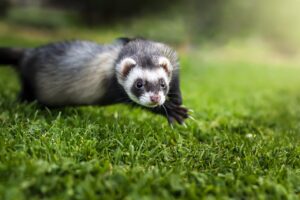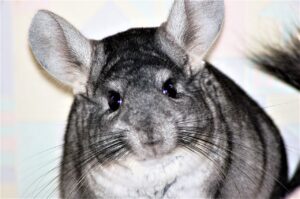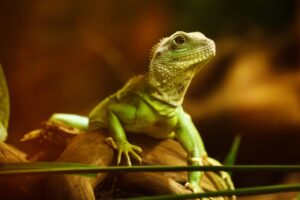Introduction to Other Types of Pets: Beyond Cats and Dogs
Welcome to the fascinating world of unconventional pets! While cats and dogs may be the most popular companions, there’s a diverse array of other pets that can bring joy and companionship into your life. From charming rabbits and playful ferrets to colorful fish and exotic reptiles, our guide to other types of pets explores the unique characteristics and care requirements of these delightful creatures. Discover the quirks and charms of small mammals, birds, amphibians, and more, and find the perfect pet that suits your lifestyle and interests. Join us on this exciting journey as we uncover the wonders of the animal kingdom beyond the typical furry friends, and get ready to meet your new, extraordinary companion.
Ferrets
Info
Ferrets are fascinating creatures known for their playful and curious nature. Here are some key characteristics, habits, and other information about ferrets:
Characteristics:
Size: Ferrets are small carnivorous mammals, typically measuring around 15-20 inches (38-51 cm) in length, including their tail.
Appearance: They have a sleek, elongated body with short legs, a long tail, and a pointed snout. Their fur can vary in color, including sable, albino, silver, and cinnamon.
Lifespan: Ferrets typically live for around 6-10 years, though some can live longer with proper care.
Habits and Behavior:
Social Animals: Ferrets are highly social animals and are often kept in pairs or groups. They enjoy interacting with both humans and other animals.
Playful: Known for their playful antics, ferrets are active and enjoy toys, tunnels, and opportunities to explore.
Sleep Patterns: Ferrets are crepuscular, meaning they are most active during dawn and dusk. They can sleep for up to 18 hours a day, often in short bursts.
Scent Marking: Ferrets have scent glands, particularly on their hindquarters, that they use for marking territory.
Diet: Ferrets are obligate carnivores, meaning they require a diet high in animal protein. Commercial ferret food or high-quality cat food is typically recommended, supplemented with occasional treats like eggs or small pieces of cooked meat.
Care:
Housing: Ferrets require a spacious cage with multiple levels, bedding, and places to hide. They should have regular opportunities to explore outside of their cage in a ferret-proofed area.
Grooming: Ferrets have a naturally clean coat and do not require frequent baths. Regular grooming, including nail trimming and ear cleaning, is recommended.
Health: Regular veterinary check-ups are important to monitor their health, as ferrets can be prone to certain illnesses such as adrenal disease and insulinoma.
Legal Considerations:
Ownership: Check local laws and regulations before getting a ferret, as they are considered exotic pets in some regions and may have specific legal requirements.
Ferrets make energetic and affectionate pets for those willing to provide them with the social interaction, mental stimulation, and specialized care they need.
Chinchillas
Info
Chinchillas are adorable and unique rodents known for their soft fur and charming personality. Here are the characteristics, habits, and other information about chinchillas:
Characteristics:
Size: Chinchillas are small rodents, typically measuring around 9-15 inches (23-38 cm) in length, excluding their bushy tails which can add another 5-6 inches (13-15 cm).
Fur: They have incredibly dense and soft fur, known for its luxurious texture. Their fur is so dense that they cannot get wet easily, which makes them susceptible to fungal infections if exposed to moisture.
Color: Chinchillas come in various colors, including gray, beige, white, black, and even mosaic patterns.
Lifespan: Chinchillas can live for 10-20 years with proper care, making them relatively long-lived for small rodents.
Habits and Behavior:
Nocturnal: Chinchillas are nocturnal animals, meaning they are most active during the night and early morning hours. They tend to rest during the day.
Social: Chinchillas are social creatures and thrive in pairs or small groups. They enjoy companionship and can become depressed if kept alone.
Chewing: Chinchillas have constantly growing teeth, so they need plenty of chew toys and wooden blocks to keep their teeth worn down and healthy.
Dust Baths: Chinchillas have special grooming habits and take dust baths to keep their fur clean and oil-free. They roll around in fine dust (not water) to maintain their coat.
Jumpers and Climbers: Chinchillas are agile and love to jump and climb. Providing them with plenty of space and opportunities for exercise is essential.
Care:
Housing: Chinchillas need a spacious cage with multiple levels for climbing and exploring. The cage should have a solid floor (not wire) to protect their delicate feet.
Diet: Chinchillas are herbivores and require a diet high in fiber. They should be fed a combination of high-quality pellets, hay (timothy or orchard grass), and occasional treats like dried fruits or vegetables.
Temperature: Chinchillas are sensitive to heat and humidity. They thrive in cool, dry environments (ideal temperature range is 60-70°F or 15-21°C).
Handling: Chinchillas can be skittish and may not enjoy being held or cuddled like some other pets. Gentle and patient handling is important to build trust.
Health:
Dental Care: Regularly check their teeth for signs of overgrowth or malocclusion, which can affect their ability to eat.
Veterinary Care: Annual check-ups with a veterinarian experienced in exotic pets are recommended to monitor their health and address any issues early.
Hygiene: Clean the cage regularly to prevent bacterial buildup, and provide fresh dust for their baths.
Chinchillas are delightful pets for those willing to provide them with the specific care they need. Their unique behaviors and soft fur make them a joy to observe and interact with.
Gold Fish
Info
Characteristics of Goldfish
Appearance:
Size: Goldfish vary widely in size depending on their breed and environment. They can range from a few inches to over a foot in length in some cases.
Coloration: Goldfish are known for their vibrant colors, which can include shades of orange, red, yellow, white, and combinations thereof. The “gold” coloration is typical, but variations include calico, black, and metallic scales.
Physical Features: They have a streamlined body with a pair of fins on either side, a dorsal fin on their back, and a tail fin. Their scales are usually shiny and reflective.
Species and Varieties:
Goldfish (Carassius auratus) are a freshwater fish species belonging to the carp family (Cyprinidae). There are numerous varieties bred through selective breeding, each with distinct colors, body shapes, and fin configurations.
Habitat and Distribution
Habitat:
Goldfish are originally native to East Asia, particularly China. They are now widely distributed around the world as popular aquarium and ornamental pond fish.
They thrive in freshwater environments with calm waters, moderate temperatures, and ample oxygen. They prefer environments with vegetation and places to hide.
Distribution:
In the wild, goldfish populations are found in ponds, lakes, and slow-moving rivers across East Asia. They have also been introduced and established in many other parts of the world due to their popularity as pets.
Habits and Behavior
Diet:
Goldfish are omnivorous and feed on a variety of foods. In the wild, they consume plant matter, algae, small crustaceans, and insects. In captivity, they are commonly fed commercial fish flakes or pellets, supplemented with fresh vegetables, and occasional live foods like brine shrimp or bloodworms.
Social Structure:
Goldfish are generally social and can be kept in groups, although they may exhibit some territorial behaviors, especially in smaller tanks or ponds with limited space.
They are relatively peaceful towards other fish species but can show aggressive behaviors towards their own kind, especially during breeding season or if resources are limited.
Activity Patterns:
Goldfish are diurnal, meaning they are most active during the day and rest at night. They are known for their playful and curious behaviors, often exploring their surroundings and interacting with objects and tank mates.
Reproduction and Lifespan
Breeding:
Goldfish reach sexual maturity at around 1 to 2 years of age, depending on their size and growth rate. They are prolific breeders under suitable conditions, with females releasing hundreds to thousands of eggs during spawning events.
Spawning typically occurs in warmer temperatures and in environments with plenty of plants or spawning mops for egg attachment.
Development and Growth:
Goldfish eggs hatch within a few days, depending on water temperature. The fry (young fish) initially feed on their yolk sacs and then transition to small live foods or commercial fry food.
They grow rapidly in their first year and continue to grow throughout their lives, although growth rate can vary significantly based on genetics, diet, and environmental factors.
Lifespan:
In captivity, goldfish can live for an average of 10 to 15 years, and some may even exceed 20 years with proper care and a healthy environment. Lifespan can vary depending on genetics, water quality, diet, and tank size.
Care and Maintenance
Tank Requirements:
Goldfish require a spacious aquarium or pond with ample room to swim and grow. They are sensitive to water quality, so regular maintenance, including water changes and filtration, is essential.
Decorate their tank with plants, rocks, and hiding places to mimic their natural habitat and provide mental stimulation.
Water Conditions:
Goldfish prefer cool water temperatures ranging from 65 to 75 degrees Fahrenheit (18 to 24 degrees Celsius), depending on the variety. They are sensitive to sudden changes in water temperature and quality.
Feeding:
Feed goldfish a balanced diet consisting of high-quality fish flakes or pellets. Supplement their diet with fresh vegetables like peas, zucchini, and spinach, as well as occasional treats like bloodworms or brine shrimp.
Avoid overfeeding, as goldfish are prone to obesity and related health issues. Feed them small amounts several times a day, only as much as they can consume in a few minutes.
Conservation Status
Goldfish are not considered endangered or threatened in the wild due to their widespread distribution and adaptability to various habitats. However, their introduction into non-native ecosystems can pose risks to native fish species and aquatic environments.
Cultural Significance
Goldfish have cultural significance in various parts of Asia, particularly in China and Japan, where they are associated with luck, prosperity, and longevity. They are often kept as ornamental fish in ponds, tanks, and bowls.
Unique Adaptations
Color Variations:
Goldfish exhibit a wide range of color variations and patterns due to selective breeding. Varieties include the common goldfish, comet, fantail, oranda, ryukin, and more, each prized for their unique appearance.
Longevity:
With proper care, goldfish can live for several decades in captivity, making them one of the longest-living aquarium fish species. Their longevity and adaptability contribute to their popularity as pets.
Understanding these aspects of goldfish biology, behavior, and care requirements is essential for providing them with a suitable and enriching environment in captivity, whether in aquariums or outdoor ponds.
Hamster
Info
Hamsters are small rodents that make popular pets due to their cute appearance, low maintenance needs, and entertaining behaviors. Here are the characteristics, habits, and other information about hamsters:
Characteristics:
Size: Hamsters are typically small, measuring around 4-7 inches (10-18 cm) in length, depending on the species.
Appearance: They have stout bodies with short legs and tails. Their fur can vary widely in color and pattern, including golden, brown, gray, black, and combinations thereof.
Lifespan: Hamsters generally live for 2-3 years, although some species like the Roborovski hamster can live up to 4 years with proper care.
Habits and Behavior:
Nocturnal: Hamsters are nocturnal animals, meaning they are most active during the night and prefer to sleep during the day. This can affect their interaction patterns with owners.
Burrowing: In the wild, hamsters create elaborate burrows for nesting and storage. Pet hamsters also enjoy burrowing in bedding materials provided in their cage.
Cheek Pouches: Hamsters have expandable cheek pouches that they use to carry and store food, allowing them to gather and transport food efficiently.
Grooming: Hamsters are clean animals and spend time grooming themselves. They may also groom their cage mates if kept in pairs or groups.
Chewing: Like many rodents, hamsters have continuously growing teeth. They need chew toys and blocks to wear down their teeth and prevent overgrowth.
Care:
Housing: Hamsters should be housed in a spacious cage with a solid bottom (to avoid foot injuries) and plenty of bedding material for burrowing. Wire cages with narrow spacing are ideal to prevent escape.
Diet: A balanced diet for hamsters includes commercial hamster pellets supplemented with fresh fruits, vegetables, and occasional treats like nuts or seeds. Fresh water should always be available.
Exercise: Hamsters are active and need opportunities for exercise. Providing a wheel (solid surface, not wire) and toys like tunnels or climbing structures can keep them entertained.
Socialization: While some species (like dwarf hamsters) can be kept in pairs or small groups, others (like Syrian hamsters) are solitary and should be housed alone to prevent aggression.
Health:
Hygiene: Clean the cage regularly to maintain hygiene and prevent health issues. Spot clean bedding daily and replace it completely every 1-2 weeks.
Health Checks: Monitor your hamster’s health regularly. Signs of illness include lethargy, loss of appetite, changes in fur or skin condition, and difficulty breathing.
Veterinary Care: If your hamster shows signs of illness or injury, seek veterinary care from a veterinarian experienced with small rodents.
Hamsters are delightful pets for families and individuals looking for small, entertaining companions. With proper care and attention to their specific needs, hamsters can live happy and healthy lives in captivity.
Hedgehogs
Info
Hedgehogs are fascinating small mammals known for their distinct appearance and nocturnal habits. Here are the characteristics, habits, and other information about hedgehogs:
Characteristics:
Size: Hedgehogs typically measure around 5-8 inches (13-20 cm) in length, with a stout body covered in spines.
Appearance: They have a round body with short legs and a pointed snout. Their spines are stiff, hollow hairs made of keratin, and can be erect or laid flat depending on the hedgehog’s state of alertness or comfort.
Color: Hedgehogs come in various colors and patterns, including combinations of brown, white, gray, and black.
Lifespan: In captivity, hedgehogs can live for 4-6 years on average, although some may live longer with proper care.
Habits and Behavior:
Nocturnal: Hedgehogs are primarily nocturnal, meaning they are most active during the night and sleep during the day. This makes them more suitable as pets for those who are also active during the evening hours.
Defense Mechanism: When threatened or startled, hedgehogs roll into a tight ball, with their spines facing outward to protect their vulnerable underside.
Diet: Hedgehogs are omnivorous, with a diet consisting mainly of insects, supplemented by fruits, vegetables, and occasionally small amounts of meat. Commercial hedgehog food is also available.
Socialization: While hedgehogs are solitary animals in the wild, they can bond with their human caregivers through gentle handling and interaction.
Habitat: Hedgehogs are adaptable and can live in a variety of habitats, from forests and grasslands to urban gardens. In captivity, they require a spacious enclosure with hiding spots, bedding material for burrowing, and an exercise wheel.
Care:
Housing: Provide a cage or enclosure that is escape-proof and has plenty of space for the hedgehog to move around. A solid-bottom cage with good ventilation is essential.
Temperature: Hedgehogs are sensitive to temperature extremes. Maintain a temperature range of 72-80°F (22-27°C) in their habitat, avoiding drafts and direct sunlight.
Grooming: Hedgehogs are generally clean animals and groom themselves. However, they may benefit from occasional foot baths to clean their feet and spines.
Handling: Handle hedgehogs gently and with care, supporting their body to avoid injury or stress. They may curl into a ball when nervous, but with patience, they can become accustomed to handling.
Health:
Health Checks: Monitor your hedgehog for signs of illness, including weight loss, changes in appetite, lethargy, or unusual behavior. Regular veterinary check-ups are recommended.
Hygiene: Clean the cage regularly, replacing bedding and removing uneaten food to maintain cleanliness and prevent health issues.
Hedgehogs can make unique and rewarding pets for dedicated owners willing to meet their specific needs for diet, habitat, and care. Their quirky behaviors and distinctive appearance add to their charm as companion animals.
Pet Lizards
Info
Pet lizards come in various species, each with unique characteristics and care requirements. Here’s an overview of the characteristics, habits, and other information about pet lizards:
Characteristics:
Size: Lizards vary greatly in size, from tiny species like geckos (a few inches long) to larger species such as iguanas (over 6 feet long).
Appearance: They have elongated bodies, usually with four legs (though some, like snakes, are legless), and scales covering their skin. Colors and patterns vary widely among species.
Diet: Lizards are primarily carnivorous, herbivorous, or omnivorous depending on the species. Their diet may include insects, small mammals, plants, fruits, and vegetables.
Habitat: Lizards come from diverse habitats, including deserts, rainforests, and grasslands. Their captive environment should mimic their natural habitat as closely as possible.
Habits and Behavior:
Basking: Many lizards are ectothermic (cold-blooded), relying on external heat sources to regulate their body temperature. They bask under heat lamps or UVB bulbs to stay warm and aid digestion.
Activity Levels: Activity levels vary among species. Some, like monitors and iguanas, are highly active and require ample space to roam, climb, and explore. Others, like certain geckos, are more sedentary.
Social Behavior: While some lizards are solitary, others are social and may benefit from living in pairs or groups. Always research the specific social needs of your lizard species before housing them together.
Handling: Lizards have varying temperaments. Some tolerate handling well, while others are more prone to stress and may not enjoy frequent handling. Always approach and handle lizards gently and with care.
Care:
Housing: Provide a spacious enclosure that allows for natural behaviors such as climbing and basking. The enclosure should have secure lids (for terrestrial species) or screens (for arboreal species) to prevent escape.
Temperature and Lighting: Maintain appropriate temperatures and lighting. Most lizards require a temperature gradient within their enclosure, with a warm basking spot and cooler areas. UVB lighting is crucial for species that require it to synthesize vitamin D3.
Substrate: Use appropriate substrate based on your lizard’s species and habitat preferences. Substrates can include sand, soil, bark, or reptile carpet.
Diet: Feed your lizard a varied diet suitable for its species. This may include live insects (like crickets, mealworms, or roaches), fresh fruits, vegetables, and commercially prepared reptile diets.
Hydration: Provide a shallow dish of fresh water for drinking. Some species may also benefit from misting to maintain humidity levels.
Health:
Regular Check-ups: Schedule regular veterinary check-ups with a veterinarian experienced in reptile care to monitor your lizard’s health and detect any potential issues early.
Quarantine: Introduce new lizards to your collection cautiously and consider quarantining them to prevent the spread of diseases to existing pets.
Cleanliness: Keep the enclosure clean by regularly removing waste and replacing substrate. Disinfect and clean feeding dishes and water bowls regularly.
Pet lizards can be fascinating and rewarding pets for reptile enthusiasts willing to provide them with proper care, suitable habitat, and attention to their specific needs. Always research the requirements of the particular species you’re interested in to ensure you can meet their needs throughout their lifespan.
Rabbit
Info
Rabbits are adorable and social animals known for their gentle demeanor and soft fur. Here’s an overview of their characteristics, habits, and other information:
Characteristics:
Size: Rabbits vary in size depending on the breed, ranging from small breeds like the Netherland Dwarf (weighing around 2-2.5 lbs or 0.9-1.1 kg) to larger breeds like the Flemish Giant (weighing up to 14 lbs or 6.4 kg).
Appearance: They have compact bodies with long ears, whiskers, and soft fur. Rabbits come in a wide variety of colors and patterns.
Lifespan: With proper care, rabbits can live for 8-12 years or longer, depending on the breed and health.
Habits and Behavior:
Social Nature: Rabbits are social animals and enjoy the company of humans as well as other rabbits. They can form strong bonds with their owners and may enjoy gentle petting and interaction.
Chewing: Rabbits have continuously growing teeth, so they need access to hay and chew toys to wear down their teeth and prevent dental problems.
Grooming: Rabbits are clean animals and groom themselves regularly. They may also appreciate being brushed to remove loose fur, especially during shedding seasons.
Hiding and Burrowing: In the wild, rabbits create burrows for nesting and hiding from predators. In captivity, they may exhibit digging behavior and appreciate tunnels or hideouts in their environment.
Activity Levels: Rabbits are crepuscular, meaning they are most active during dawn and dusk. They need space to hop, run, and explore, so providing a large enclosure or safe, supervised play area is important.
Care:
Housing: Provide a spacious enclosure or indoor space that allows for hopping, stretching, and exploration. Outdoor hutches should be secure from predators and weather-resistant.
Diet: A rabbit’s diet should consist mainly of hay (such as timothy or orchard grass), fresh vegetables (like leafy greens and carrots), and a small amount of high-quality rabbit pellets. Fresh water should always be available.
Handling: Handle rabbits gently and support their hindquarters to avoid injury. Some rabbits may not enjoy being picked up, so respect their preferences and provide positive interactions.
Healthcare: Schedule regular veterinary check-ups to monitor your rabbit’s health, trim their nails, and check their teeth. Spaying or neutering is recommended to prevent reproductive health issues and reduce aggression.
Litter Training: Rabbits can be litter trained like cats. Provide a litter box filled with rabbit-safe litter and encourage them to use it by placing hay inside.
Interaction and Enrichment:
Toys and Enrichment: Provide chew toys, tunnels, and cardboard boxes for rabbits to play with and explore. Rotate toys regularly to keep them engaged.
Socialization: Spend time interacting with your rabbit daily, offering gentle petting and positive reinforcement. Rabbits can bond closely with their owners and may enjoy supervised playtime outside their enclosure.
Rabbits make wonderful pets for families and individuals willing to provide them with proper care, attention, and a stimulating environment. Understanding their unique behaviors and needs can help ensure a happy and healthy life for your pet rabbit.
Snake
Info
Snakes are fascinating reptiles known for their elongated bodies, limbless form, and diverse adaptations. Here’s an overview of their characteristics, habits, and other information:
Characteristics:
Size: Snakes vary greatly in size, from small species like the thread snake (less than 4 inches or 10 cm long) to large species like the reticulated python (can exceed 20 feet or 6 meters in length).
Appearance: They have long, cylindrical bodies covered in scales. Snakes lack limbs and external ears, and their eyes have clear scales instead of movable eyelids.
Diet: Snakes are carnivorous, feeding primarily on rodents, birds, insects, fish, and other small animals. Some larger species can even prey on larger mammals and birds.
Habitat: Snakes inhabit a wide range of environments, including forests, grasslands, deserts, and aquatic habitats. Their specific habitat preferences vary by species.
Habits and Behavior:
Movement: Snakes move by slithering, using their muscles and scales to push against surfaces. They can move quickly when necessary, but many species move slowly to conserve energy.
Hunting: Snakes are skilled hunters, using a combination of stealth and ambush tactics to capture prey. Some species are constrictors, squeezing their prey to subdue it, while others use venom to immobilize prey.
Hibernation: In colder climates, some snake species hibernate during the winter months to conserve energy when temperatures drop.
Defense Mechanisms: Snakes have various defense mechanisms, including camouflage, mimicry, venom, and warning displays (like hissing or flattening their bodies).
Care:
Housing: Provide a secure enclosure that allows for movement and hides for security. The enclosure size varies by species, with arboreal snakes needing vertical space and terrestrial species needing floor space.
Temperature and Humidity: Maintain appropriate temperatures and humidity levels based on your snake’s species and habitat preferences. This often includes a thermal gradient with a warm basking spot and cooler areas.
Substrate: Use suitable substrate, such as aspen shavings, newspaper, or reptile carpet, depending on the species. Avoid substrates that can be ingested or cause impaction.
Feeding: Feed your snake a diet appropriate for its species and size. This typically includes thawed rodents for most species, with larger snakes needing larger prey items.
Handling: Handle snakes gently and confidently, supporting their body to avoid injury. Regular handling from a young age can help snakes become accustomed to human interaction.
Health:
Veterinary Care: Schedule regular check-ups with a veterinarian experienced in reptile care to monitor your snake’s health and detect any potential issues early.
Quarantine: Introduce new snakes to your collection cautiously and consider quarantining them to prevent the spread of diseases to existing pets.
Hygiene: Keep the enclosure clean by regularly removing waste and replacing substrate. Disinfect and clean water dishes and hides as needed.
Understanding the specific needs and behaviors of your snake species is crucial for providing a suitable environment and ensuring their health and well-being as captive pets. Always research the requirements of your snake species and consult with reptile experts or veterinarians for guidance.
Turtle
Info
Turtles are fascinating reptiles known for their distinctive shell and semi-aquatic lifestyles. Here’s an overview of their characteristics, habits, and other information:
Characteristics:
Shell: Turtles are characterized by their protective shell, which consists of an upper carapace and a lower plastron. The shell is made of bone covered by keratinous scutes.
Size: Turtles vary widely in size depending on the species. Some are small, like the musk turtle (4-5 inches or 10-13 cm), while others, like the leatherback sea turtle, can reach over 6 feet (1.8 meters) in length.
Lifespan: Turtles can have long lifespans, with some species living for several decades or even over a century in captivity with proper care.
Habits and Behavior:
Habitat: Turtles are found in a variety of habitats, including freshwater lakes, ponds, rivers, swamps, and oceans. Some species are strictly aquatic, while others, like box turtles, spend more time on land.
Basking: Turtles are ectothermic (cold-blooded) and regulate their body temperature by basking in sunlight or under heat lamps. Basking is crucial for digestion and overall health.
Feeding: Turtles are omnivorous or herbivorous, depending on the species. They eat a varied diet that may include aquatic plants, insects, small fish, and commercial turtle pellets. Proper nutrition is essential for their health and growth.
Hibernation: Many turtle species hibernate during the winter months, often burying themselves in mud or finding sheltered spots to survive cold temperatures.
Swimming: Aquatic turtles are strong swimmers and spend much of their time in water, using their webbed feet or flippers to propel themselves.
Care:
Housing: Provide an appropriate enclosure that meets the specific needs of your turtle species. Aquatic turtles need a large aquarium or pond with ample swimming space, while terrestrial turtles require a spacious terrarium with land and water areas.
Temperature and Lighting: Maintain proper temperatures and provide UVB lighting to help turtles metabolize calcium and maintain overall health. Use a basking lamp to create a warm spot where turtles can thermoregulate.
Water Quality: For aquatic turtles, maintain clean, filtered water with proper depth for swimming and basking. Regular water changes are necessary to prevent bacterial growth and maintain water quality.
Substrate: Use suitable substrate, such as river rocks, sand, or aquatic plants, depending on the turtle species and habitat requirements.
Feeding: Offer a varied diet that includes commercial turtle pellets, fresh vegetables (like leafy greens and carrots), and occasional live or frozen prey (like insects or fish) for protein.
Health:
Veterinary Care: Schedule regular check-ups with a veterinarian experienced in reptile care to monitor your turtle’s health, trim their nails, and check their shell and skin for signs of disease or injury.
Handling: Handle turtles gently and support their body to avoid stress or injury. Wash your hands before and after handling to prevent the spread of bacteria.
Turtles can be rewarding pets for responsible owners willing to provide them with appropriate housing, diet, and care. Understanding the specific needs of your turtle species is essential for their long-term health and well-being.








